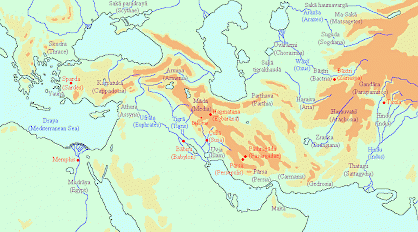Sattagydians
Q1149207Sattagydia (Old Persian Thataguš, country of the "hundred cows"): satrapy of the ancient Achaemenid empire, perhaps the mountains between Iran and Pakistan.

Sattagydia is mentioned for the first time in section 21 of the Behistun inscription of the Persian king Darius I the Great, which was commissioned in 521 BCE:
King Darius says: While I was in Babylon, these provinces revolted from me: Persia, Elam, Media, Assyria, Egypt, Parthia, Margiana, Sattagydia, and Scythia.
The text does not explain how and when the rebellion was suppressed, which suggests that the fighting did not need the king's personal involvement and could be left to local officials. The alternative is that the revolt was suppressed much later, perhaps in 515, when Darius conquered the valley of the Indus.
Sattagydia also appears in the Persian tribute list that is part of the Histories of the Greek researcher Herodotus of Halicarnassus. The Sattagydians are mentioned in one breath with the Dadicae and Aparytae, tribes that are otherwise unknown. The inscription on Darius' tomb at Naqš-i Rustam and the Daiva inscription of king Xerxes also mention Sattagydia as a satrapy of the Achaemenid empire.
After 480, Sattagydia disappears from our sources. In the Persian army list (a document that contains the battle array of the army that invaded Greece and is included in the Histories of Herodotus), the Sattagydians are not mentioned. They may be identical to the Paricani or (to use the Persian name) Barikânu, "mountain people". The Greek historian Arrian of Nicomedia seems to refer to these people as Oreitans, which is a translation of "mountain people".
It is possible that Sattagydia is not the mountain area, but the country immediately beyond it: the central Indus plain.
It has been assumed that the name of the city of Sittakê in Mesopotamia, the capital of Sittacene, is derived from Babylonian URU Sattagû, "city of the Sattagydians", in which case the town may have been a colony of eastern military settlers or deportees.